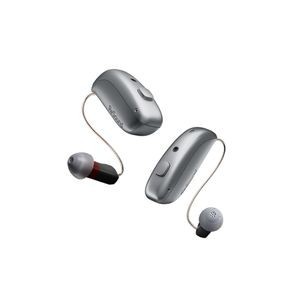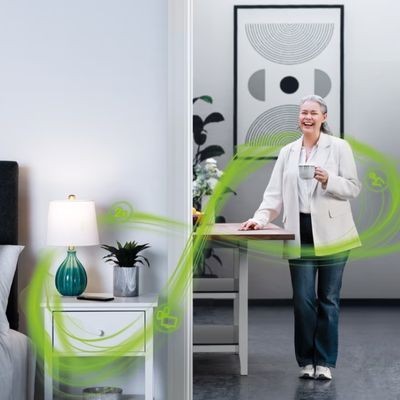
Head of Online Medical Content

Audiology Expert at Hearing Aid UK

Resound Vivia vs Nexia: Which hearing aid is right for you?
Understanding the difference between two great hearing aids from the same manufacturer
Overview | The key differences | What they share | Choose Vivia if... | Choose Nexia if... | A comparison | Key takeaways | Conclusion
Overview
If you're researching Resound hearing aids, you've likely come across both the Vivia and the Nexia - and frankly, it's rather confusing working out which one you actually need.
Both are excellent hearing aids from the same manufacturer, both launched within the past couple of years, and both look remarkably similar. So what's the actual difference, and why does it matter?
The short answer is that Vivia is Resound's latest flagship model, released in early 2025, whilst Nexia came out in late 2023. Here's where things get really interesting, though - the main difference isn't just about being newer, it's about what technology they've packed inside.
The key differences: AI processing
The headline feature that separates Vivia from Nexia is artificial intelligence - specifically, Vivia includes Resound's first-ever Deep Neural Network (DNN) chip dedicated to noise reduction. Nexia doesn't have this.
This DNN chip in the Vivia has been trained on 13.5 million spoken sentences in various real-world noisy environments. The training data represents roughly 25 years' worth of real-world conversations, which means the AI has effectively "listened" to decades of speech patterns, accents, and noise scenarios.
This extensive training is what allows the chip to distinguish between speech and noise so effectively - it's not guessing, it's drawing on a vast library of learned experiences.
When you activate the "Intelligent Focus" feature, the hearing aids don't just reduce noise randomly - they prioritise speech based on your line of sight. If you're looking at someone whilst they're speaking, the aids recognise this and enhance their voice specifically.
It's rather clever, actually - the technology understands that you're typically looking at the person you want to hear, and it uses this natural behaviour to help focus the AI processing where it matters most.
In practical terms, this means Vivia can deliver up to 17 times more efficient noise reduction than previous models. If you regularly find yourself in challenging listening environments - busy restaurants, family gatherings, meetings with multiple speakers - this additional AI processing could make a genuine difference.
Nexia, on the other hand, relies on excellent but more traditional noise reduction technology. It still delivers a 150% improvement in speech understanding compared to older Resound models, which is genuinely impressive. It's not that Nexia doesn't handle noise well - it does - it's just that Vivia has additional dedicated hardware specifically for this challenge.
What they share
Honestly, these two hearing aids have more similarities than differences. Both feature:
- Bluetooth LE Audio and Auracast compatibility - They're both future-proofed for the next generation of public sound systems in cinemas, theatres, and airports.
Nexia was actually the world's first hearing aid with working Auracast when it launched, and Vivia continues this capability.
- The same compact design - Despite adding a second chip for the DNN, Vivia maintains the same small form factor as Nexia.
The microRIE model is still the smallest rechargeable Receiver-in-Canal (RIC) hearing aid on the market, which is particularly appreciated if you wear glasses.
- Excellent battery life - Both offer up to 30 hours on a single charge without streaming, or 24 hours with continuous streaming. The portable charging case provides multiple full charges on the go.
- 360-degree sound processing - Both use Resound's 360 Chip to process sound from all directions, creating a natural listening experience no matter where you are.
- M&RIE receiver option - Both can be fitted with a microphone in the receiver (the bit that goes in your ear), which reduces wind and handling noise whilst improving spatial awareness.
- The Resound Smart 3D app - Both connect to the same comprehensive app, offering features like "Check My Fit" (which uses your phone camera to ensure you're wearing them correctly), remote adjustments from your audiologist, and the Auracast Assistant for easy connection to public broadcasts.
- IP68 rating - Both have the same level of water and dust resistance, meaning they'll handle rain, splashes, and everyday life without complaint.
Accessories and connectivity
Both Vivia and Nexia work with Resound's comprehensive range of accessories, though it's worth knowing what's actually available if you need additional support in specific situations:
The Multi Mic+ is particularly useful if you regularly attend meetings or lectures - it picks up speech from across a room and streams it directly to your hearing aids. The Micro Mic is a smaller, more discreet option that clips onto a companion's clothing for one-to-one situations in noisy environments.
For television watching, both the Resound TV Streamer+ and the Unite TV Streamer 2 allow direct streaming to your aids without disturbing others in the room. If you're not using a smartphone or prefer physical controls, the Unite Remote Control 2 gives you easy access to volume and programme changes.
Charging options include the Standard Charger (perfectly adequate for home use), the Premium Charger (which includes a power bank for charging on the go), and the Desktop Charger for those who prefer a compact desktop solution.
Both hearing aids support Made for iPhone (MFi) connectivity for Apple devices and Android Streaming for Hearing Aids (ASHA) for compatible Android phones.
This means direct audio streaming without requiring additional accessories - your phone talks directly to your hearing aids using Bluetooth LE Audio, which is more energy-efficient than older Bluetooth standards and provides better sound quality for music and calls.
The Unite Phone Clip+ is available if you have an older Android device that doesn't support ASHA, or if you simply prefer having a separate device for call handling.

Choose Vivia if:
You regularly struggle in noisy environments and need the absolute best speech-in-noise performance available. The dedicated AI chip is specifically designed for people who find restaurants, pubs, and busy social gatherings genuinely challenging.
If this is where you struggle most, the additional investment in Vivia's AI processing could be worthwhile.
You want the latest technology and are willing to pay a premium for it. Vivia represents the cutting edge of Resound's current lineup, and if having the newest available technology matters to you, this is it.
Important note: The DNN chip is only available in the top-tier Vivia 9 level AND only in the rechargeable model. If you're considering the Vivia 7 or 5 technology levels, or if you want non-rechargeable batteries, you won't get the AI processing, which rather defeats the purpose of choosing Vivia over Nexia.

Choose Nexia if:
You want excellent hearing aid technology at a better price point. Nexia still delivers outstanding performance, including that 150% improvement in speech understanding and all the modern connectivity features, without the premium pricing of Vivia.
You don't primarily struggle in extremely noisy environments. If your main challenges are with everyday hearing - understanding conversation in reasonably quiet settings, hearing the television, and managing phone calls, Nexia handles all of this brilliantly without needing the additional AI processing.
You prefer having a proven product. Nexia has been on the market since late 2023, which means there's more real-world feedback and any early teething problems have been ironed out.
Vivia vs Nexia comparison chart
| Feature | Resound Vivia | Resound Nexia |
|---|---|---|
| Launch Date | February 2025 | September 2023 |
| Deep Neural Network (DNN) AI Chip | ✅ Yes (Vivia 9 rechargeable only) | ❌ No |
| Speech-in-Noise Performance | Up to 17x more efficient with DNN active | 150% improvement vs older models |
| Intelligent Focus Feature | ✅ Yes (AI-powered, manual activation) | ❌ No |
| Battery Life (rechargeable) | Up to 30 hours (20 hours with streaming/DNN) | Up to 30 hours (24 hours with streaming) |
| Bluetooth LE Audio | ✅ Yes | ✅ Yes |
| Auracast Compatibility | ✅ Yes (fully activated) | ✅ Yes (fully activated) |
| MicroRIE Size | Same compact design | Same compact design |
| 360-Degree Sound Processing | ✅ Yes | ✅ Yes |
| M&RIE Receiver Option | ✅ Yes | ✅ Yes |
| IP68 Water/Dust Resistance | ✅ Yes | ✅ Yes |
| ReSound Smart 3D App | ✅ Yes | ✅ Yes |
| Check My Fit Feature | ✅ Yes | ✅ Yes |
| Technology Levels Available | 9, 7, 5, 4 | 9, 7, 5 |
| Replaceable Mic Filters | ✅ Yes (patient-replaceable) | ❌ No (standard design) |
| Available Styles | microRIE, RIE, BTE, Custom ITE/ITC/CIC | microRIE, RIE, BTE, Custom ITE/ITC/CIC |
| CROS for Single-Sided Deafness | ✅ Yes | ✅ Yes |
| Colour Options | 8 standard + Navy Blue & Red | 8 standard options |
| Charging Time | 3 hours for full charge | 3 hours for full charge |
| Portable Charger | ✅ Yes (3 full charges) | ✅ Yes (3 full charges) |
| Typical Price Range | Premium (newest model) | Advanced (better value) |
| Best For | Extreme noise environments, latest AI tech | Excellent all-round performance, better value |
Key takeaways
✔️ The main difference is AI - Vivia includes a dedicated Deep Neural Network chip for noise reduction; Nexia doesn't. This additional processing can help significantly in very noisy environments.
✔️ The AI is only in Vivia 9 rechargeable - if you're considering lower technology levels or non-rechargeable models, you won't get the DNN chip, making the choice between Vivia and Nexia less significant.
✔️ Both have the same excellent foundation - Bluetooth LE Audio, Auracast compatibility, tiny size, 30-hour battery life, and comprehensive app control are standard on both.
✔️ Nexia offers better value - it still delivers a 150% improvement in speech understanding compared to older models, which is genuinely impressive technology at a lower price point.
✔️ Choose based on your actual needs - if you constantly struggle in very noisy environments, Vivia's AI could be worthwhile. For most everyday hearing challenges, Nexia performs brilliantly.
✔️ Professional fitting matters more than the model - either hearing aid will only perform at its best with proper programming from a qualified audiologist.
✔️ We offer both - as truly independent audiologists, we stock the full range from all manufacturers. Our recommendation will be based on your hearing loss, lifestyle, and budget - not on which model gives us better margins. That's the advantage of independent advice.
✔️ Try before you commit - with our free home visits across the UK and 60-day money-back guarantee, you can experience either hearing aid in your own environment with no risk.
Conclusion
Here's the honest truth - both are excellent hearing aids, and for many people, Nexia will do everything they need at a lower price point. The additional AI processing in Vivia is genuinely clever technology, but it's not necessary for everyone.
The key question is: do you regularly find yourself in situations where background noise makes conversation genuinely difficult, and would you benefit from dedicated AI hardware tackling this specific problem?
If the answer is yes, and you're prepared to invest in the top-tier Vivia 9 rechargeable model, then Vivia could make a real difference to your daily life.
If your answer is "not really" or "sometimes, but not constantly," then Nexia offers outstanding hearing aid technology with all the modern features you actually need, without paying for AI processing you won't fully utilise.
Either way, the most important factor is proper fitting and programming by a qualified professional. Both hearing aids benefit enormously from real ear measurement and personalised adjustment - which is exactly what our audiologists provide, either in clinic or during free home visits anywhere in the UK.
Why Choose Us?
- FREE Hearing Tests
- Best Hearing Aids and Prices
- FREE Aftercare for Life
- FREE Home Visits
- 200+ Local Audiologists
- 60 Day Money Back Guarantee
Resound Vivia vs Nexia hearing aids
Not sure which option is right for you?
Our audiologists can help you decide between Vivia and Nexia based on your actual hearing loss and lifestyle - not on which model gives us better margins.
That's the advantage of truly independent advice.
Free home visits available across the UK • 60-day money-back guarantee • Lifetime aftercare included
Other hearing aid technology articles you might like...
 Deep Neural Networks in Hearing Aids
Deep Neural Networks in Hearing Aids  Resound Vivia AI vs Nexia
Resound Vivia AI vs Nexia  Phonak Infinio Ultra vs Phonak Infinio
Phonak Infinio Ultra vs Phonak Infinio Watch the Resound Vivia AI hearing aid video below
Our specialist service includes:
Do not spend hundreds of pounds without getting a second opinion from us.
Please call us on 0800 567 7621
 Not only are the prices great, but the service is fantastic! Many thanks to your team.
Not only are the prices great, but the service is fantastic! Many thanks to your team.What's included in our hearing aid prices?
Common FAQs about hearing aids and hearing loss
In general, any audiologist will always recommend to you the hearing aid model that best suits your needs. Here is a useful checklist to make sure that is the case.
- Audiologist's level of knowledge: The audiologist you have seen will hopefully have a wide knowledge of all available hearing aids; however, some will only be familiar with a small number of brands and, therefore, may not really be in a position to know which model is the best for you. It is OK to challenge their recommendation and ask them to justify why this particular brand is the one for you.
- Do research: Read about the hearing aid that was recommended. Does it seem like it will suit your lifestyle? Does it have more or fewer features than you need?
- Be aware of sales targets: Many high street retailers have specific tie-ins to a particular manufacturer/brand. The hearing aid they have suggested may still be the correct one for you, but do your research so that you know why they might have recommended it.
If you have significant hearing loss in both ears, you should be wearing two hearing aids. Here are the audiological reasons why:
Localisation: The brain decodes information from both ears and compares and contrasts them. By analysing the minuscule time delays as well as the difference in the loudness of each sound reaching the ears, the person is able to accurately locate a sound source.
Simply put, if you have better hearing on one side than the other, you can't accurately tell what direction sounds are coming from.
Less amplification is required: A phenomenon known as “binaural summation” means that the hearing aids can be set at a lower and more natural volume setting than if you wore only one hearing aid.
Head shadow effect: High frequencies, the part of your hearing that gives clarity and meaning to speech sounds, cannot bend around your head. Only low frequencies can. Therefore, if someone is talking on your unaided side, you are likely to hear that they are speaking, but be unable to tell what they have said.
Noise reduction: The brain has its own built-in noise reduction, which is only really effective when it is receiving information from both ears. If only one ear is aided, even with the best hearing aid in the world, it will be difficult for you to hear in background noise as your brain is trying to retain all of the sounds (including background noise) rather than filtering them out.
Sound quality: We are designed to hear in stereo. Only hearing from one side sounds a lot less natural to us.
Fancy some further reading on this topic? You can read about why two hearing aids are better than one in our article, hearing aids for Both Ears, here
For most people, the main benefit of a rechargeable hearing aid is simple convenience. We are used to plugging in our phones and other devices overnight for them to charge up. Here are some other pros and cons:
For anybody with poor dexterity or issues with their fingers, having a rechargeable aid makes a huge difference, as normal hearing aid batteries are quite small and some people find them fiddly to change.
One downside is that if you forget to charge your hearing aid, then it is a problem that can't be instantly fixed. For most, a 30-minute charge will get you at least two or three hours of hearing, but if you are the type of person who is likely to forget to plug them in regularly, then you're probably better off with standard batteries.
Rechargeable aids are also a little bit bigger and are only available in Behind-the-Ear models.
Finally, just like with a mobile phone, the amount of charge you get on day one is not going to be the same as you get a few years down the line. Be sure to ask what the policy is with the manufacturer's warranty when it comes to replacing the battery.
For most people, the answer is yes. But it's never that simple.
The majority of hearing problems affect the high frequencies a lot more than the low ones. Therefore, open fitting hearing aids sound a lot more natural and ones that block your ears up can make your own voice sound like you are talking with your head in a bucket. Therefore, in-ear aids tend to be less natural.
However, the true answer is we can't tell until we have had a look in your ears to assess the size of your ear canal, and until we have tested your hearing to see which frequencies are being affected.
People with wider ear canals tend to have more flexibility, also there are open fitting modular CIC hearing aids now that do not block your ears.
There is also the age-old rule to consider, that a hearing aid will not help you if it's sat in the drawer gathering dust. If the only hearing aid you would be happy wearing is one that people can't see, then that's what you should get.
Most people can adapt to any type of hearing aid, as long as they know what to expect. Have an honest conversation with your audiologist as to what your needs are.
Generally speaking, six or more. Unless it's none at all. The number of channels a hearing aid has is often a simplistic way an audiologist will use to explain why one hearing aid is better than another, but channels are complex, and it is really not that straightforward. Here are some reasons why:
Hearing aids amplify sounds of different frequencies by different amounts. Most people have lost more high frequencies than low, and therefore need more amplification in the high frequencies. The range of sounds you hear is split into frequency bands or channels, and the hearing aids are set to provide the right amount of hearing at each frequency level.
Less than six channels, and this cannot be done with much accuracy, so six is the magic number. However, a six-channel aid is typically very basic with few other features and is suitable only for hearing a single speaker in a quiet room. The number of channels is not what you should be looking at; it's more the rest of the technology that comes with them.
As a final note, different manufacturers have different approaches. One method is not necessarily better than any other. For example, some manufacturers have as many as 64 channels in their top aids. Most tend to have between 17 and 20. One manufacturer has no channels at all.
Manufacturer's warranties typically last between 2-5 years, depending on the brand and model, and cover defects in materials and workmanship. This includes repairs for component failures, electronic malfunctions, and manufacturing defects, but excludes damage from misuse, accidents, or normal wear. Most manufacturers also include loss and damage insurance for the first year.
We handle all warranty claims on your behalf, liaising with manufacturers and ensuring you get replacement devices quickly when needed. This comprehensive warranty coverage, combined with our lifetime aftercare, gives you complete peace of mind.
Our hearing tests are completely free, whether at our clinics or in your home. Unlike other providers who charge £30-£100 for home visits, we believe hearing healthcare should be accessible without financial barriers. Our comprehensive assessments include examination by a registered audiologist, audiogram results, and personalised recommendations.
All testing, future adjustments, and ongoing support are included at no extra cost. While NHS tests are also free, typical 6-week waiting periods often lead people to seek immediate private testing. We provide prompt, professional assessments that fit your schedule and budget.
Yes, we offer completely free home visits throughout the UK, and this service is included in our prices with no additional charges. Home visits are particularly valuable for people with mobility issues, busy schedules, or those who simply prefer the comfort and convenience of their own environment.
Our audiologists can conduct full hearing tests, fit hearing aids, and provide ongoing support in your home. This service sets us apart from many providers who either don't offer home visits or charge extra for them.
We can offer prices up to 40% lower than high street retailers because of our business model. As a network of 200+ independent audiologists, we don't have the massive overheads of large retail chains - no expensive high street premises, no sales targets pushing audiologists to sell the most expensive options, and no costly marketing campaigns.
However, we maintain the same buying power as the big chains because we purchase on behalf of our entire nationwide network. This means you get access to the same premium hearing aids with professional service, but at genuinely competitive prices.
We offer a comprehensive 60-day money-back guarantee, which gives you twice the industry standard time to properly assess whether your hearing aids are right for you. This extended period recognises that adjusting to hearing aids takes time, and your brain needs several weeks to adapt to the amplified sounds.
Unlike many providers who offer just 30 days, we believe 60 days gives you the confidence to test your hearing aids in all the situations that matter to you - from quiet conversations at home to busy restaurants and outdoor activities.
Other pages you might find useful
Ask the Experts
6 Morton Lane
Walkwood
Redditch
Worcestershire
B97 5QA
Latest Launch
When we refer to a product as 'Latest Launch', we mean it is the latest to be released on the market.
New
When we refer to a product as 'New', we mean that the product is the newest hearing aid model on the market.
When we refer to a product as 'Superseded', we mean that there is a newer range available which replaces and improves on this product.
Older Model
When we refer to a product as an 'Older Model', we mean that it is has been superseded by at least two more recent hearing aid ranges.
